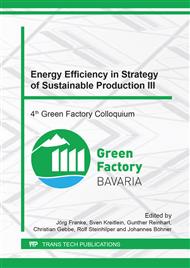p.27
p.36
p.44
p.52
p.60
p.69
p.77
p.87
p.97
Virtual Process Data Linkage of Assembly Stations in High Variance Workshop Production
Abstract:
The advance of digitalization changes the requirements of processes in industrial production and assembly. For this reason, production and assembly must now be able to execute complex process steps. This is about quality and productivity expectations, as well as flexibility and reliability of production, lines and plants [1]. Today, data is generated by almost every system, machine and sensor, yet it is hardly used for process optimization. Manufacturing processes are usually organized as workshop production or chained production systems, in addition to standalone machines [2,3]. Most analytic projects focus on chained systems and serial production, unlike individual machines and specific workshop production. Depending on manufacturing IT, process data from serial production is stored in data bases, which are usually optimized for traceability. Standalone machines and machines within workshop production are scarcely connected to a common data base. The required process data is stored either on the module itself or inside a local data base [4]. The identification of dependencies between individual assembly processes, energy data and the quality of the finished product is necessary for an extended optimization. These optimizations can be process-specific, as well as environmental and resource related. Due to decentralized process data storages, an overall view of a dynamic order-oriented value chain is denied. Therefore, the potential of the machines is largely unused. Based on Data Mining, this advanced development can be counteracted by process monitoring and optimization. Therefore, this paper provides a solution for a virtual process data linkage of assembly stations. This enables the acquisition, processing, transformation and storage of unstructured raw data by special software and methods, which is also able to cope with chained production systems and standalone machines. For further analysis of interdependencies, a visualization is developed for advanced monitoring and optimization [5,6].
Info:
Periodical:
Pages:
60-68
Citation:
Online since:
October 2017
Authors:
Price:
Сopyright:
© 2017 Trans Tech Publications Ltd. All Rights Reserved
Share:
Citation:


